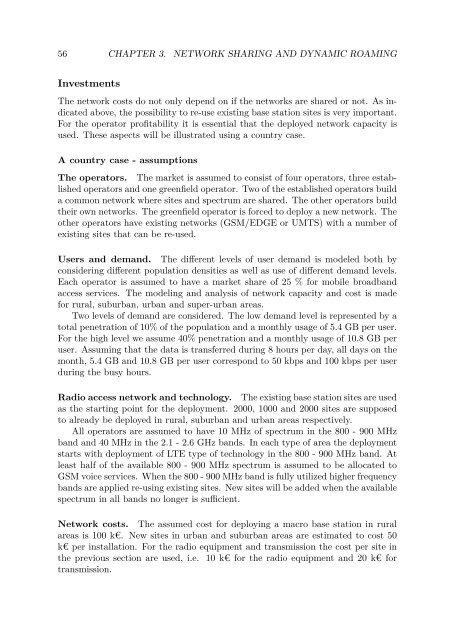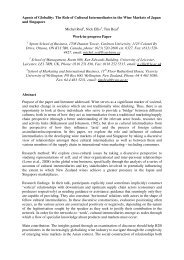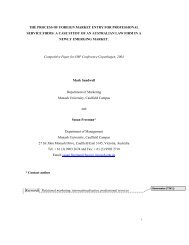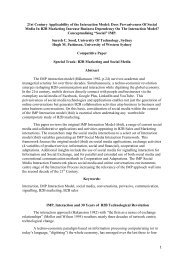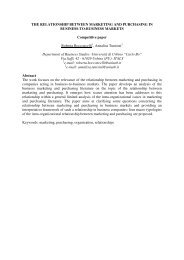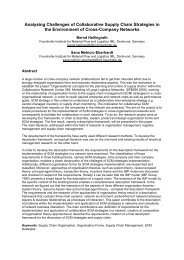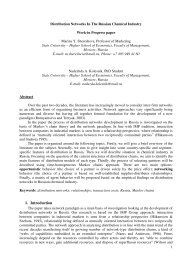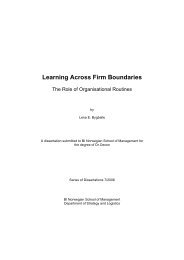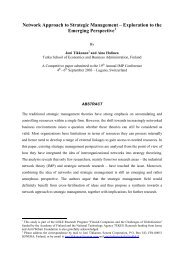Mobile Network Operators and Cooperation - IMP Group
Mobile Network Operators and Cooperation - IMP Group
Mobile Network Operators and Cooperation - IMP Group
You also want an ePaper? Increase the reach of your titles
YUMPU automatically turns print PDFs into web optimized ePapers that Google loves.
56 CHAPTER 3. NETWORK SHARING AND DYNAMIC ROAMING<br />
Investments<br />
The network costs do not only depend on if the networks are shared or not. As indicated<br />
above, the possibility to re-use existing base station sites is very important.<br />
For the operator profitability it is essential that the deployed network capacity is<br />
used. These aspects will be illustrated using a country case.<br />
A country case - assumptions<br />
The operators. The market is assumed to consist of four operators, three established<br />
operators <strong>and</strong> one greenfield operator. Two of the established operators build<br />
a common network where sites <strong>and</strong> spectrum are shared. The other operators build<br />
their own networks. The greenfield operator is forced to deploy a new network. The<br />
other operators have existing networks (GSM/EDGE or UMTS) with a number of<br />
existing sites that can be re-used.<br />
Users <strong>and</strong> dem<strong>and</strong>. The different levels of user dem<strong>and</strong> is modeled both by<br />
considering different population densities as well as use of different dem<strong>and</strong> levels.<br />
Each operator is assumed to have a market share of 25 % for mobile broadb<strong>and</strong><br />
access services. The modeling <strong>and</strong> analysis of network capacity <strong>and</strong> cost is made<br />
for rural, suburban, urban <strong>and</strong> super-urban areas.<br />
Two levels of dem<strong>and</strong> are considered. The low dem<strong>and</strong> level is represented by a<br />
total penetration of 10% of the population <strong>and</strong> a monthly usage of 5.4 GB per user.<br />
For the high level we assume 40% penetration <strong>and</strong> a monthly usage of 10.8 GB per<br />
user. Assuming that the data is transferred during 8 hours per day, all days on the<br />
month, 5.4 GB <strong>and</strong> 10.8 GB per user correspond to 50 kbps <strong>and</strong> 100 kbps per user<br />
during the busy hours.<br />
Radio access network <strong>and</strong> technology. The existing base station sites are used<br />
as the starting point for the deployment. 2000, 1000 <strong>and</strong> 2000 sites are supposed<br />
to already be deployed in rural, suburban <strong>and</strong> urban areas respectively.<br />
All operators are assumed to have 10 MHz of spectrum in the 800 - 900 MHz<br />
b<strong>and</strong> <strong>and</strong> 40 MHz in the 2.1 - 2.6 GHz b<strong>and</strong>s. In each type of area the deployment<br />
starts with deployment of LTE type of technology in the 800 - 900 MHz b<strong>and</strong>. At<br />
least half of the available 800 - 900 MHz spectrum is assumed to be allocated to<br />
GSM voice services. When the 800 - 900 MHz b<strong>and</strong> is fully utilized higher frequency<br />
b<strong>and</strong>s are applied re-using existing sites. New sites will be added when the available<br />
spectrum in all b<strong>and</strong>s no longer is sufficient.<br />
<strong>Network</strong> costs. The assumed cost for deploying a macro base station in rural<br />
areas is 100 k€. New sites in urban <strong>and</strong> suburban areas are estimated to cost 50<br />
k€ per installation. For the radio equipment <strong>and</strong> transmission the cost per site in<br />
the previous section are used, i.e. 10 k€ for the radio equipment <strong>and</strong> 20 k€ for<br />
transmission.


